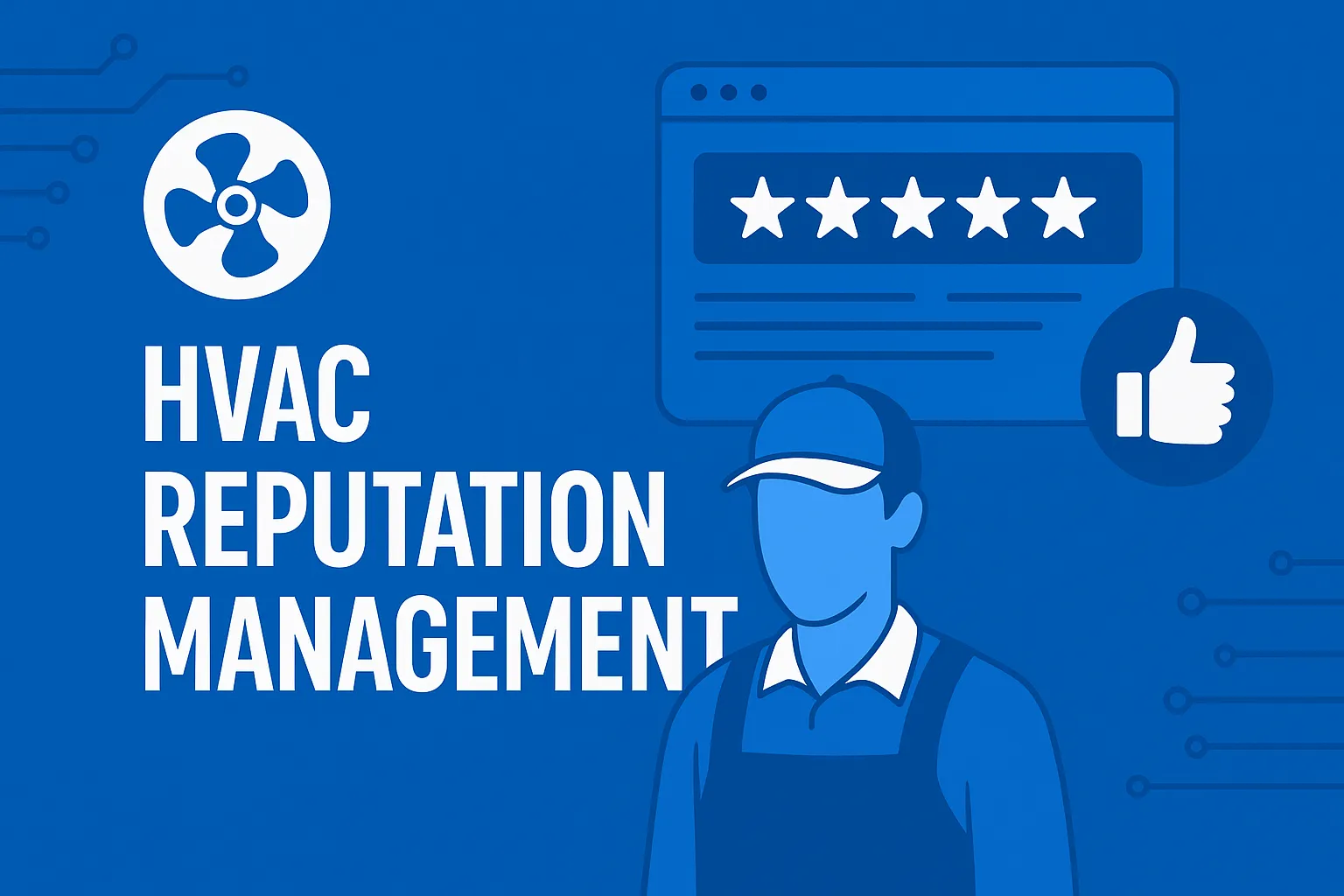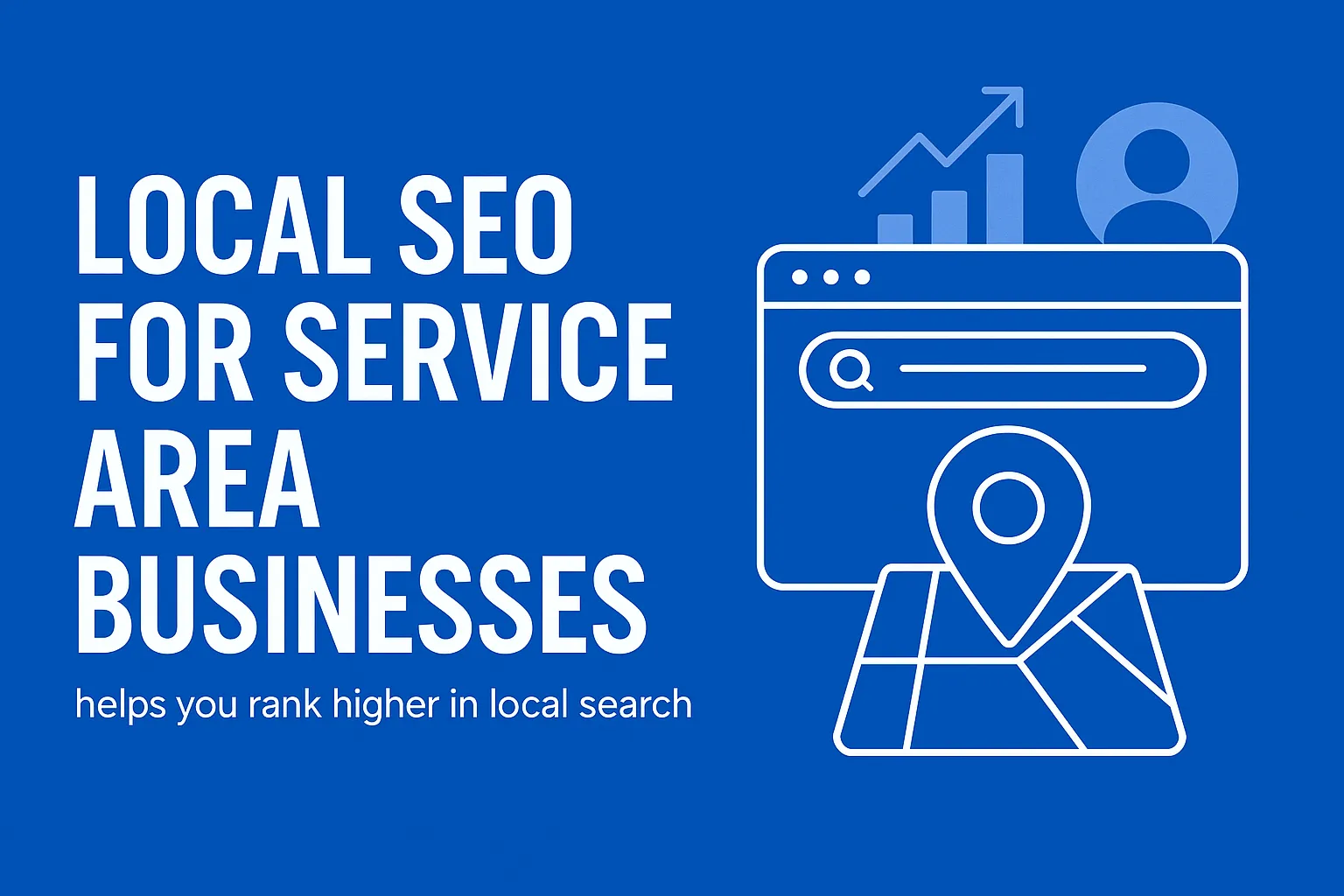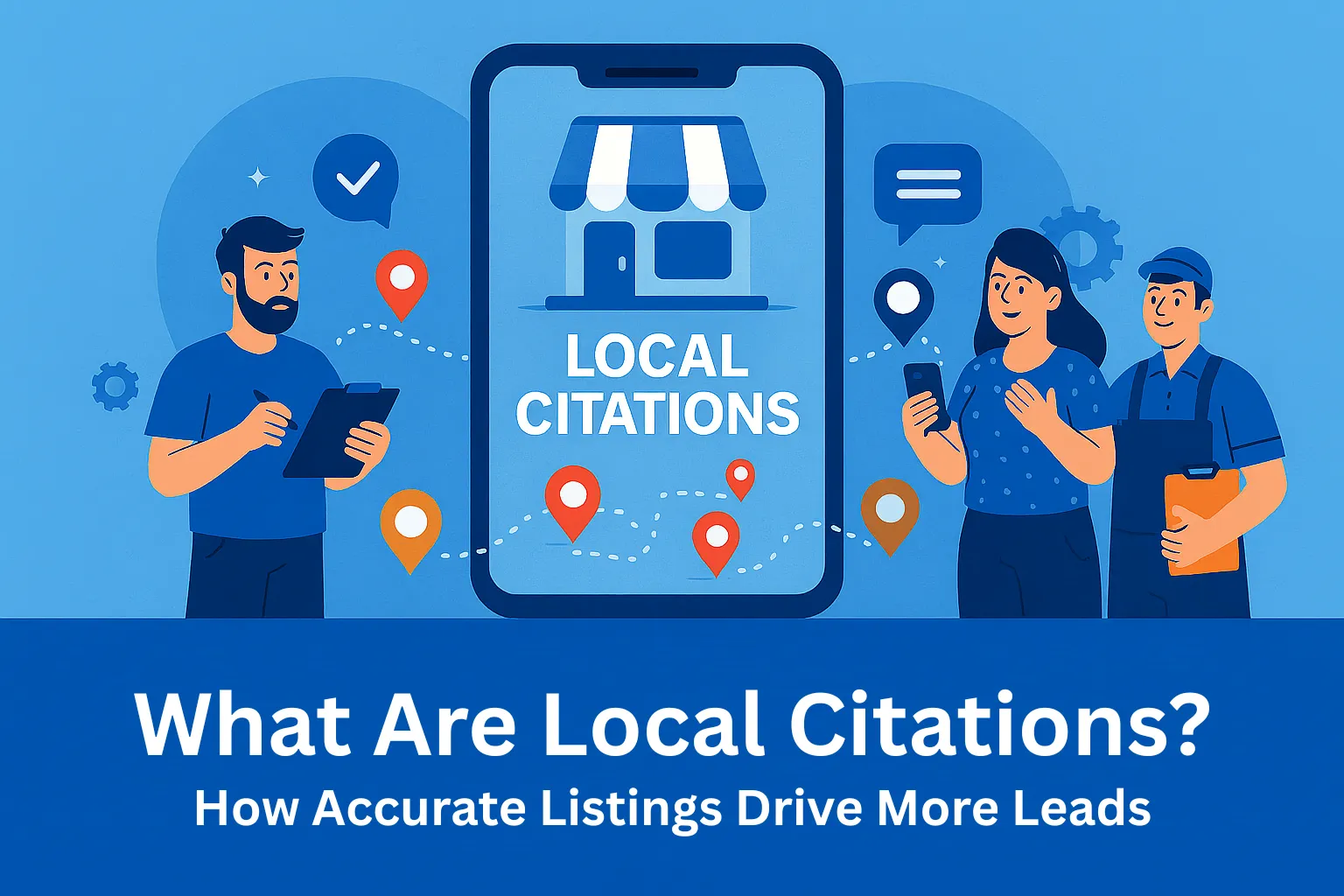Before You Go—Let’s Boost Your Leads!
Join our community of successful HVAC and Plumbing contractors who trust Klutch Growth to enhance their online presence.
Klutch Growth Blog
HVAC Reputation Management: Boost Leads & Local SEO
Customers judge HVAC companies fast. Most of that judgment comes from online reviews, local search visibility, and how well your business shows up in the Google Local Pack. That’s why HVAC reputation management matters. One negative review can push your listing down. Strong, consistent feedback can move you up.
Local search shapes almost half of all Google activity. About 46% of searches have local intent. When your Google Business Profile is accurate and supported by steady positive reviews, Google treats it as trust. That trust influences visibility. It also matters to the 81% of consumers who read Google reviews before they choose a local service.
High-intent “near me” searches are rising steadily, especially for urgent service needs such as “AC repair near me.” In markets where service-area businesses compete for the same leads, a strong reputation system can help you secure map-pack placement without heavy ad spend.
This guide breaks down HVAC reputation management step by step. You’ll learn how to automate review requests, respond to issues fast, recover from negative feedback, and deploy reputation signals that research shows can significantly boost revenue and lead quality. The goal is simple: strengthen your online presence and turn search visibility into booked jobs.

Why Reputation Management Is Critical for HVAC Businesses
Homeowners rely on simple trust signals when an AC fails at night or when they face a major purchase like a heat-pump replacement. Online reviews and local search visibility shape most of these decisions. About 86% of consumers read reviews for local businesses. About 93% say reviews influence what they buy.
For HVAC contractors, reviews guide both ranking and customer choice. Strong, recent feedback improves visibility in local search results. Profiles with clear credentials, fast responses, and consistent review activity help homeowners feel safe choosing a provider.
Negative reviews create the opposite effect. A 2025 survey shows that more than half of consumers stop using a business after a poor experience. For HVAC companies, even one unresolved complaint can reduce calls, especially in competitive local markets.
Reputation management supports every step of the customer journey. It improves how often you appear in search. It affects how often people click. It shapes whether a homeowner calls you or moves on to someone else.
How Online Reputation Impacts Local SEO and Lead Generation
Online reviews influence how HVAC companies appear in local search. Google uses review volume, rating quality, and recency as signals when ranking local businesses. Profiles with steady positive reviews earn better visibility in the Local Pack. This matters because 42% of local searchers click on Map Pack results.
Reviews also shape homeowner decisions. Research shows 86% of consumers consider reviews important when deciding which local business to trust, and 93% say reviews affect their buying choices. Strong feedback increases clicks and calls. Negative feedback lowers them.
An organized HVAC reputation management system supports consistent review growth. It strengthens your local ranking signals. It improves engagement from searchers. It also helps reduce the impact of unresolved complaints.
Reviews as a Local Ranking Factor
Google treats reviews as an important part of local SEO. The rating, the number of reviews, and how recent they are all shape where a business appears in search.
Higher ratings help you look trustworthy. A larger review count strengthens your presence in the local results. Reviews that mention your service and location also help Google confirm what you do and where you operate.
Fresh activity matters. A profile that earns new reviews each month stays competitive. A profile that sits untouched slowly loses visibility.
The Local Pack captures roughly 40% to 45% of clicks for local searches. Strong, steady reviews increase your chances of landing in that section.
For HVAC contractors, this makes ongoing review generation one of the most reliable ways to support local rankings and lead growth.
Reputation → Visibility → Leads
Online reputation management for HVAC contractors builds a clear funnel: a high-rated Google Business Profile (GBP) secures top visibility in “emergency HVAC near me” queries, boosting click-through rates (CTR) by 25% for 3-5 star listings, according to BrightLocal’s 2025 data. That visibility converts 80% of local searches to calls or visits, with reviewed businesses booking 30% more jobs as trust accelerates the search-to-dispatch handoff.
For HVAC contractors, every review counts. Maintaining recent, positive feedback supports local search performance and helps turn search visibility into booked jobs.
Promoting Your Reputation Across Channels
Your online reputation works best when it appears everywhere customers look. HVAC contractors can strengthen trust by sharing reviews across Google Business Profile, Yelp, Facebook, and Angi. These platforms influence local decisions and help homeowners compare service quality.
Social proof improves engagement. Research shows that 88% of consumers trust online reviews as much as personal recommendations. Adding real customer feedback to ads, emails, and service pages increases the chances that a homeowner chooses your company when they need help.
Each platform supports a different form of proof.
On Facebook, share project photos and link to recent reviews.
On Yelp, reply to feedback to show active customer care.
On Angi, highlight verified credentials and completed projects.
On Google Business Profile, keep hours, services, and updates accurate.
A consistent presence across these channels supports your overall rating and builds confidence before a customer calls. For HVAC contractors, this improves conversion during peak seasons when homeowners need fast, reliable service.
Core Strategies for HVAC Reputation Management
Now that you know why reputation matters, here are the core tactics HVAC contractors use during busy seasons and heavy local competition. These strategies focus on automation, fast follow-up, and using customer feedback in your marketing. Since 82% of consumers check reviews before they contact a local business, a strong system helps you build steady reviews, improve visibility, and increase the chances that searchers turn into calls.
Automate Review Requests
Automated review requests help HVAC contractors collect more feedback with less effort. After a job is finished, send a quick email or text while the experience is still fresh. Use tools that can trigger these messages right after the tech closes the work order, so the customer can respond with little friction.
Platforms like Podium and Birdeye make the process simple. They send short, direct messages that feel personal instead of pushy. They also collect reviews from multiple platforms in one place, which helps you stay organized and respond quickly.
Automation helps you build a steady stream of fresh reviews. It also improves visibility in local search because Google rewards active profiles. For busy HVAC teams, an HVAC reputation management service can set this up, keep messaging compliant with FTC guidelines, and make sure every request comes across as authentic.
Monitor and Respond to Reviews Quickly
Swift monitoring across GBP, Yelp, and Facebook prevents one bad ductwork job in humid Houston from snowballing into a reputation repair nightmare. Use dashboards in tools like Birdeye or Podium to consolidate alerts, spotting negatives within hours; this is crucial since 55% of HVAC complaints stem from delays, according to 2025 Workyard statistics.
Response etiquette for negative reviews? Stay calm, sincere, and solution-oriented. Say something like: “We’re sorry your AC lagged during that heatwave.” Outline your fixes: e.g., “We’ve scheduled your next tune-up at no charge and retrained our team on timely diagnostics.” Invite the reviewer to continue offline. Properly handled, a negative review can be mitigated and may preserve future business.
Quick replies signal to Google’s algorithm you’re customer-obsessed, enhancing local rankings and social proof for HVAC companies.
Keep Listings Updated Across Platforms
Inaccurate listings are silent killers for HVAC business listings management, confusing algorithms, and costing leads valuable spots in competitive markets. Prioritize GBP accuracy: Update hours for 24/7 emergency slots, detail services like “ductless mini-split installs,” and refine service areas to cover suburbs without overclaiming.
Sync this with directories; Yelp for urban reviews, Angi for vetted pros, BBB for trust badges to maintain NAP consistency, avoiding 15-20% ranking drops from mismatches. Tools from an HVAC company reputation management agency automate audits, flagging drifts quarterly. This vigilance ensures online reviews align with real ops, fortifying social proof and preventing reputation repair from outdated “closed” flags that scare off storm-weary callers.
Promote Positive Reviews and Testimonials
Showcasing online reviews transforms passive praise into aggressive lead magnets for social proof for HVAC companies. Embed top testimonials on your HVAC website’s homepage slider, such as “5 stars for lightning-fast boiler fix in snowy Denver!” using widgets that pull live Google feeds, driving 22% higher conversions per BrightLocal 2025 data.
Amplify it in social media campaigns: Instagram Reels featuring “lifesaver during blackout” with before-and-after photos, or Facebook ads targeting “HVAC tips for Texas summers” with star ratings. Add them to Google Posts for timely boosts, such as seasonal “Winter Prep Specials” that highlight rave reviews.
Partnering with an HVAC reputation management agency ensures ethical promotion, turning one-off fixes into viral trust builders that outshine generic ads.
Optimize HVAC Website for Reputation and SEO
Your website is one of the best places to combine reputation signals with local SEO. Create service area pages for specific locations and place real customer reviews on each page. Tools like WP Review or similar plugins make it easy to embed ratings and testimonials so visitors see proof of your work without leaving the site.
Structured data strengthens this even further. Adding Review schema markup helps search engines understand your testimonials and can make your pages eligible for rich snippets in search results. This improves visibility and supports higher click-through rates, especially for local service pages. Pair your reviews with local keywords to reinforce relevance and give crawlers clear context.
If you’re not comfortable handling code or markup, an HVAC company reputation management agency can take care of the setup. They ensure your review embeds load well on mobile, display consistently across pages, and support conversions during busy seasons.
Leverage Google Business Profile & Local Services Ads
Your Google Business Profile is one of the strongest HVAC visibility tools you have. Keep your categories accurate, upload job photos from the areas you serve, and answer common questions such as “How fast can you handle furnace emergencies?” These updates help Google understand your services and improve your chances of appearing in Local Pack results.
Reviews add even more weight. Respond to feedback publicly, highlight key reviews, and stay active on your profile. This signals reliability to both searchers and Google’s systems.
Local Services Ads can extend that reach. They place your business at the top of local searches with a verified badge and your average review score. Since LSAs charge only for calls, they work well for high-value HVAC jobs and urgent service requests.
Advanced Tactics to Strengthen HVAC Reputation
Advanced tactics help HVAC businesses collect more reliable feedback, monitor customer sentiment at scale, and stay consistent across every channel homeowners use to compare contractors. These methods support re-engagement, early issue detection, and faster reputation recovery. With support from HVAC company reputation management services, you can refine how to promote HVAC company profiles and maintain a strong presence in competitive markets.
Targeted Email and Direct Mail Campaigns
Targeted email and direct mail help you collect reviews and re-engage past customers. Segment your lists by service history and send simple follow-up emails that link directly to your Google review form. For direct mail, use short postcards with a past customer quote and a QR code that opens your Yelp or Google profile. This makes it easy for homeowners to leave feedback without searching for your listing.
This two-channel approach, supported by HVAC company reputation management services, encourages timely responses and reduces delay-related frustration. Since 55% of negative HVAC reviews come from delays, steady follow-ups help you capture feedback before issues grow. Tools like Constant Contact let you track opens and QR scans so you know which messages drive reviews without cluttering inboxes.
Use AI and Automation For Scale
AI tools help HVAC teams keep up with reviews during busy seasons. Deploy AI alerts for instant GBP/Yelp pings on new drops, flagging sentiment via NLP to dissect “slow response during blackout” gripes (crucial as 70% of U.S. HVAC firms juggle 100+ monthly feedback).
Birdeye’s sentiment analysis dashboards score reviews on a -1 to 1 scale, prioritizing “frustrated but fixable” ones for automated drafts: “We’re gutted about your delayed install; here’s a free filter swap to make it right.” Podium’s bots handle 40% of responses autonomously, freeing your team to focus on other tasks.
When connected to your CRM or dispatch system, AI reveals trends in customer experience. HVAC company reputation management services can manage these tools and escalate problems faster. This keeps your profiles active and supports stronger visibility when homeowners compare local contractors.
Reputation Repair and Crisis Management
Reputation issues can come from real service problems or from bad-faith attacks. When they happen, quick and transparent responses protect your credibility. Start by identifying what is real and what is not. If you see fake reviews, report them through Google’s review flagging tool or the BBB dispute process. Include job logs, dates, and service notes to show the review cannot be verified.
Legitimate complaints need a different approach. Acknowledge the issue, explain what happened, and outline what you are doing to fix it. If delays were caused by storms, part shortages, or heavy call volume, be clear about the cause and the steps you’re taking to prevent similar issues. Short updates on social media or through email help customers understand the situation and reduce frustration.
HVAC company reputation management services can support this work with audits, documentation reviews, and organized responses. They can also turn resolved incidents into helpful service examples or FAQs that strengthen your online footprint and improve search relevance.
Cross-Channel Reputation Building
Homeowners check several platforms before choosing an HVAC contractor, so your reputation needs to appear consistently across social media, business directories, and local community channels. Sharing job highlights, customer stories, and short repair demos on Instagram, Facebook, and LinkedIn helps customers see your expertise in real situations. These posts also reinforce trust, since most consumers view reviews as reliable as personal recommendations.
Local involvement adds another layer. Sponsoring community events, supporting trade programs, or partnering with realtors for home-maintenance workshops helps your brand show up outside of digital feeds. These activities often lead to organic posts and mentions that strengthen your online presence and signal reliability to homeowners comparing providers.
An online HVAC local reputation management system or HVAC company reputation management services can coordinate this activity. They help track mentions, maintain consistent branding across platforms, and connect reviews to your marketing efforts. This multi-channel approach expands your visibility and shows customers the same dependable reputation wherever they encounter your business.
Tracking HVAC Reputation and Measuring ROI
Tracking your reputation across platforms helps you understand how reviews influence search visibility and lead generation. Tools that monitor feedback, Google Business Profile activity, and call performance show how customer sentiment affects real revenue. This data also clarifies how to get leads for HVAC business growth, since positive reviews often correlate with higher call rates, form submissions, and booked jobs.
Review Monitoring Tools
Empower HVAC lead generation with review monitoring tools that centralize feedback for fast action during peak seasons. A unified dashboard can track review generation across dozens of platforms and connect with your job-management system to flag sentiment dips after service appointments, improving response times for contractors.
Some systems automate SMS review requests and pin local listings, helping you collect more Google reviews in high-demand periods by prompting homeowners at the right moment. Others scan wide networks of sites for trends and run customer satisfaction surveys that highlight early signs of churn.
Tools that support real-time feedback tracking can also attribute lead increases to timely follow-ups on complaints or questions. When these features are part of an online HVAC local reputation management system, raw review data becomes actionable insight without the need for manual spreadsheets.
GBP Insights and Local SEO Metrics
GBP insights show how often homeowners take action after seeing your profile. Calls, website clicks, and direction requests help you measure visibility and interest. Verified profiles average 50 calls, 66 direction requests, and 105 website visits per month, and complete profiles are 2.7× more likely to get engagement.
Local Pack placement matters as well. About 42% of local searches lead to Map Pack clicks, so strong ratings and recent reviews directly influence where your traffic comes from. Tracking these metrics helps you see which neighborhoods engage most and which services attract the strongest intent.
Pair GBP data with customer satisfaction surveys to confirm whether search engagement matches the service experience. Regular profile audits keep your information accurate and your review activity aligned with what homeowners see, supporting both visibility and conversions.
Conversion Tracking
Conversion tracking shows how reviews influence calls, form submissions, and booked jobs. Call-tracking software links phone leads to specific actions on your Google Business Profile or website, helping you see which reviews or service pages triggered the call. This gives clearer insight into how reputation affects real HVAC lead generation.
Form fills can be tracked with UTM tags in emails, texts, and landing pages tied to review requests. This helps you compare which messages or follow-ups drive more quote requests. Tracking booked jobs through call recordings and lead tags also clarifies which campaigns produce paying customers, not just inquiries.
Pairing these tracking methods with post-job surveys shows how satisfaction levels connect to completed bookings. This creates a full view of how search visibility, reviews, and customer experience influence revenue across installations, repairs, and maintenance.
Reputation → Revenue ROI
Reputation data ties directly to HVAC revenue. Industry benchmarks place the average HVAC cost per lead at $153, which makes every improvement in rating or review volume more valuable. When your reviews strengthen search visibility and drive more profile actions, each additional call or form fill has a measurable financial impact.
Conversion benchmarks also show why review management matters. The average HVAC conversion rate sits at 3.10%, and businesses that respond to all reviews see 16.4% higher conversion rates. This makes consistent response habits, paired with steady review collection, a direct lever for generating more booked jobs.
Dashboards that track calls, form fills, and booked appointments help you connect ORM activity to revenue outcomes. When combined with customer satisfaction surveys, you can see which parts of your reputation work contribute most to lead quality and lifetime value. This creates a clear link between ongoing reputation efforts and long-term HVAC lead generation.
Common Reputation Management Mistakes (and Fixes)
1. Ignoring Negative Reviews
Mistake: Leaving negative reviews unanswered makes issues look unaddressed and reduces trust.
Fix: Set daily review alerts and respond within 24 hours with a clear apology, a brief explanation, and a next step.
2. Using Fake or Paid Reviews
Mistake: Fake or incentivized reviews damage credibility and can trigger platform penalties.
Fix: Request real feedback after each job through legitimate post-service channels and avoid incentives altogether.
3. Duplicate or Inconsistent Business Listings
Mistake: Multiple or mismatched listings confuse search engines and weaken your local SEO signals.
Fix: Audit your listings quarterly, merge duplicates, and keep NAP (name, address, phone) consistent everywhere.
4. Not Responding to Reviews at All
Mistake: Silence suggests you don’t value customer feedback.
Fix: Prepare simple templates for positive and negative reviews and commit to responding publicly within 48 hours.
5. Not Connecting ORM With SEO and Lead Generation
Mistake: Treating reviews as standalone assets wastes potential visibility and revenue.
Fix: Add testimonials to service pages, embed review schema, and track calls or form fills that originate from your review sources.
FAQs About HVAC Reputation Management
How can HVAC companies get more reviews?
The fastest way to get more HVAC reviews is to send automatic SMS or email requests immediately after each job. Research from platforms like Podium shows that customers are 2–3× more likely to leave a review when asked within the first 24 hours. Keeping the request short, with direct links to Google, boosts completion rates.
What’s the best way to handle fake reviews?
Flag fake reviews directly in your Google Business Profile using the “Report” option. Provide details such as lack of a customer record or policy violations. Google’s published review guidelines state that they remove reviews involving spam, conflicts of interest, or unsupported claims.
Can I manage my HVAC reputation without an agency?
Yes. Many small HVAC companies manage reputation in-house using free or low-cost tools like:
- Google Alerts for brand monitoring
- GBP notifications for new reviews
- Review request links sent via SMS or email
How long before reputation management improves rankings?
Most HVAC companies see clearer local SEO improvements within 3–6 months, depending on how consistently they collect new reviews and update their Google Business Profile. Google’s documentation states that fresh, high-quality reviews influence visibility in local results.
How much does an HVAC reputation management agency cost?
Most agencies offering HVAC reputation management charge for as low as $99 per year and could go up to $5,000 to $20,000, depending on services like review generation, crisis management, and local SEO. Larger markets or full-service programs can cost more.
How to promote an HVAC company?
Promote your HVAC business by focusing on:
- An optimized Google Business Profile
- Local SEO with service-area pages
- Google Local Services Ads
- Short-form videos demonstrating repairs or seasonal tips
How to get leads for an HVAC business?
Combine review-driven trust, targeted Google Ads for HVAC, local referral partnerships, and strong service pages to generate HVAC leads year-round. Homeowners rely heavily on local search, especially for urgent issues. So a well-maintained online reputation directly increases call volume.
Final Thoughts: Building a Reputation That Brings HVAC Leads
A strong online reputation is one of the most reliable ways HVAC companies can increase visibility, earn homeowner trust, and drive consistent lead growth. Reviews influence which contractors appear in local search results, how often customers call, and whether they choose you over nearby competitors. When your profiles stay updated, your reviews stay recent, and your responses stay active, you give both Google and homeowners clear signals that your business is dependable.
Reputation doesn’t improve on its own. It requires steady habits: sending review requests after every job, replying quickly to feedback, correcting listing errors, and monitoring trends across platforms. These small, repeatable actions create the momentum that raises your star ratings and strengthens your local search performance over time.
If you’re ready to improve results, start with simple steps: update your Google Business Profile, send automated review requests for the next week, and respond to recent reviews. These efforts build the foundation for higher rankings, stronger trust, and a steadier flow of qualified leads in every season.
Recent Posts
November 14, 2025
November 10, 2025
November 3, 2025
October 27, 2025




